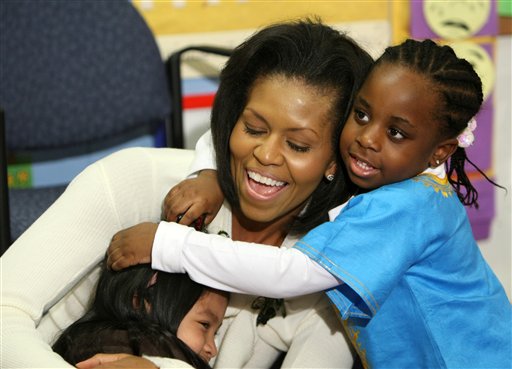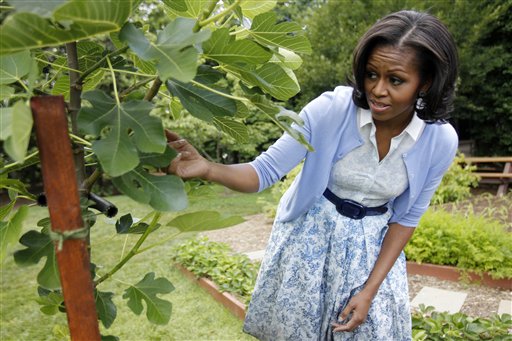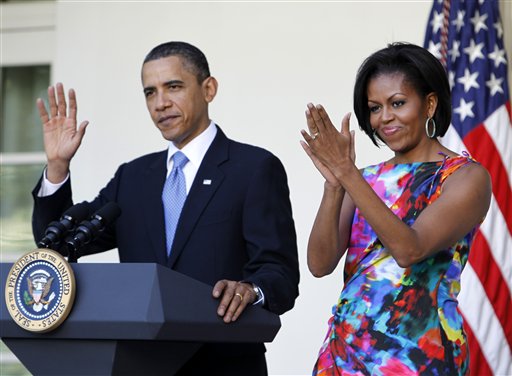She is 5-foot-11 and world famous. Sometimes she inspires awe in her admirers. She has been accused of being the angry type. So when Michelle Obama meets people, she likes to bring things down to earth with a hug.
Erin Thesing got one, before the young schoolteacher introduced Mrs. Obama to a crowd of a thousand people at a recent campaign rally in Philadelphia. As the first lady approached, Thesing extended her hand in greeting.
“She brings me in for the hug, and says, ‘It is so nice to see you, Erin.’ She knew my name,” Thesing remembers, her face bright with the memory.
It happens over and over, wherever Michelle Obama goes — the human connections made by a charismatic public person, and the careful construction of a very public figure.
How much of this is real, and how much is the kind of strategy that’s behind every first lady’s image? Can it be both? Is it even possible, in this Internet age, to know where the persona ends and the person begins?
Mrs. Obama’s representatives declined to make her available for an interview. And why would they? Her image is already set. This 48-year-old woman has already shared everything about herself that she wants us to know:
She had a working-class, two-parent childhood on the South Side of Chicago, then attended Princeton and Harvard Law. Next came marriage and two daughters with an ambitious man named Barack Obama. She held a series of corporate, government and nonprofit jobs in her hometown.
As the president’s wife, Mrs. Obama has rebounded from 2008 campaign accusations that she carries racial grudges to define herself as “mom in chief.” She’s an advocate for healthy living and military families; a workout enthusiast with arms so taut they inspired their own Twitter feed.
Despite aspersions against the strength of her patriotism and parodies of her as a food-policing busybody, Mrs. Obama’s Gallup favorability ratings have averaged a sound 66 percent as first lady. Laura Bush averaged 73 percent; Hillary Rodham Clinton 56.
This popularity is tended as carefully as Mrs. Obama’s White House vegetable garden. The tools are her social causes, and the force of her own personality.
Perhaps that personality — the real Michelle Obama — can be glimpsed through the eyes of people on the receiving end of those hugs.
In Thesing’s case, she and the first lady chatted for five minutes about things like Thesing’s students at a predominantly black charter school, Beyonce’s “Let’s Move!” remix and the Obama family dog. Thesing had been impressed by many famous political figures on the campaign trail in her native New Hampshire, but Mrs. Obama inspired stronger feelings.
“Somehow she has this ability within 30 seconds to make you feel you can open up to her,” Thesing says. “To make this instant connection.”
Before the campaign rally, Thesing had fully absorbed the first lady’s image. She viewed her as a role model: an assertive woman who successfully juggles her career, family and community service, who works out daily, has a great wardrobe and can relate to anyone.
Now that she has met her, Thesing is convinced that the image is real.
HUGS BEFORE PUBLIC
She was a hugger long before she was a public figure, say people who have known Mrs. Obama for years, and yearned to make a difference long before she became first lady.
In 1991, when Michelle Robinson was about 27 years old, she worked in a prominent Chicago corporate law firm, doing intellectual property work for entertainment companies. One supervisor, a partner named Quincy White, recalls that the young lawyer wasn’t satisfied with the nature of her work: “I couldn’t give her something that would meet her sense of ambition to change the world,” White says in the biography “Michelle,” by Liza Mundy.
So she wrote a letter to Valerie Jarrett, a deputy chief of staff to Chicago Mayor Richard M. Daley, who would soon become a mentor and close friend to Michelle and her fiance, Barack.
She took a job as an assistant to the mayor, with a lower salary than at her law firm. Soon she became an economic development coordinator, responsible for working with businesses to foster growth and jobs. After two years with the city, she left to be director of the Chicago branch of Public Allies, a nonprofit that trains young people for leadership in public service.
In 1996, she became an associate dean at the University of Chicago, directing efforts to engage students in local community service. Her first daughter, Malia, was born in 1998; Sasha arrived in 2001. A year later, with Barack in the Illinois Legislature, she moved to the University of Chicago Hospitals as executive director of community affairs.
After her husband was elected to the U.S. Senate in 2004, she was promoted to university vice president. She took leave from that job to help his presidential campaign.
Finally, as first lady, she was in a position to actually fulfill her ambition to “change the world.”
‘LET’S MOVE’
Her first initiative was “Let’s Move!” The objective: solve childhood obesity within a generation. People who have worked with her describe a meticulous planner, a goal-setter who translates big-picture strategy into actions that affect real people, a woman who is comfortable being in charge.
“Let’s Move!” is now a sprawling effort that includes corporations, teachers, government, Beyonce, and more. But the centerpiece is Mrs. Obama herself.
So one hot day in May of last year, she arrived with just 15 minutes’ notice at Alice Deal Middle School in Washington, D.C.
Beyonce’s video had just hit the Internet, and students had spent a few gym classes practicing the choreography. All the students were outside on the playground when Mrs. Obama arrived, wearing black slacks and a bright yellow blouse that showed off those arms.
The beat kicked in, the cameras started rolling and the first lady started dancing.
“I was surprised when she did the dances,” recalls health and physical education teacher Michelle Ortiz, who spent some time speaking with Mrs. Obama. “She mentioned that she didn’t know the choreography, but that she would give it a shot.”
She did what the kids did: the running man, the Dougie, the jump rope thing. She picked up the moves quickly. She spoke to the crowd, then asked if they wanted to dance some more.
“Lots of times kids have an issue because they don’t have a connection with an adult,” Ortiz says. “Like, you could never possibly understand what it’s like to be a kid. Now the first lady is doing a dance that we like to do. It shows like, wow, she’s still in touch.”
Quite literally: “She gave me a hug,” Ortiz says. “She smelled really good, like nice perfume. I didn’t realize how tall she was.”
Assistant principal Diedre Neal got one, too, and said it didn’t feel obligatory: “It’s like hugging a family member. It’s not something you can fake. . It’s more comforting, I wouldn’t say strong. Solid and comforting. Motherly.”
MICHELLE’S BUBBLE
The first lady’s bubble is a powerful thing, erected and enforced by a team of 23 staffers (about the same number as Mrs. Bush had). Unplanned encounters are rare. Coming face to face with conservatives is rarer still — but they still make themselves heard.
In the fall of 2011, she was on a trip to promote Joining Forces, another initiative that, among other things, has helped 50,000 veterans and military spouses get jobs, with commitments from 1,600 companies to hire at least 160,000 more. While being introduced with the vice president’s wife, Jill Biden, at a NASCAR race in Homestead, Fla., boos could be heard from the crowd.
Never mind that she was standing with an Army sergeant who had served in Iraq and Afghanistan, his wife and their three children. Clearly, there was something about her persona the crowd did not like.
The next day, Rush Limbaugh described it:
“We don’t like being told what to eat; we don’t like being told how much to exercise; we don’t like being told what we’ve got to drive; we don’t like wasting money; we don’t like our economy being bankrupted. We don’t like 14 percent unemployment,” the radio titan said, segueing from Mrs. Obama’s programs to conservative views of her husband’s policies.
“I’ll tell you something else,” he told his audience, estimated at 15 million people per week. “We don’t like paying millions of dollars for Mrs. Obama’s vacations.”
The vacations. Few of Mrs. Obama’s public moves have been widely labeled as gaffes, but a trip to Spain in the summer of 2010 dealt a brief blow to her otherwise steady popularity numbers.
A longtime Chicago friend was taking her daughter to Spain, and she asked Mrs. Obama to come with her younger daughter, Sasha. Despite warnings from advisers, she went, during the depths of the recession, during a week when 131,000 jobs were reported lost.
Although rules required her to reimburse the equivalent of first-class airfare, and her friends flew separately and paid for their own hotel rooms, taxpayers spent $467,585 on costs such as Mrs. Obama’s jet, Secret Service protection, and food and lodging for accompanying staff, according to documents obtained by Judicial Watch, a conservative public integrity group.
When she traveled to Aspen, Colo., in February, without the president, conservative websites listed it as the Obama family’s 16th vacation since taking office. (Opinions vary along political lines on how the Obama vacations compare to those of previous first families.)
Mrs. Obama’s clothes also have been a target.
The Obamas are worth millions thanks to the president’s best-selling books, and Mrs. Obama earned more than $300,000 in 2006 as a hospital vice president and board member. Although she makes a point of wearing inexpensive fashions from places like J. Crew and H&M, she has occasionally sported things like $515 Lanvin sneakers while volunteering at a food bank, and a $6,800 J. Mendel jacket at a Buckingham Palace reception with Queen Elizabeth II during the Olympic Games in London. (Not to mention the silvery, leather-esque jeggings she wore to the Kids Choice Awards).
All this comes on top of claims that she holds a grudge against America for its past racial sins.
On the campaign trail in 2008 she famously said: “For the first time in my adult lifetime, I am really proud of my country, and not just because Barack has done well, but because I think people are hungry for change.”
The conservative National Review magazine quickly put her on the cover with the headline “Mrs. Grievance.” The story made a claim that remains inseparable from her image on the right: “Michelle Obama embodies a peculiar mix of privilege and victimology, which is not where most Americans live.”
COMPARING FIRST LADIES
Other than the obvious fact that she is the first black first lady, how does Michelle Obama, 48, compare with other presidential wives?
Hillary Clinton was another Ivy League lawyer with a high-powered career who stood on equal footing with her husband. But Mrs. Obama has shown no desire to run for office, and her beauty and style are essential to her image while Mrs. Clinton’s appearance was often mocked.
Like Mrs. Clinton, Mrs. Obama is said to offer frequent advice to her husband, and is deployed often on the campaign trail to articulate and explain the president’s beliefs. But Mrs. Obama has not been accused of meddling in policy, a perception that dogged Mrs. Clinton.
Jacqueline Kennedy? Like Mrs. Obama, she was seen as a glamorous, modern presence who brought change to the White House — but JFK never referred to his wife as “the boss.”
Carl Sferrazza Anthony, a historian with the National First Ladies’ Library, says Mrs. Obama shares something with Clinton, Kennedy, Betty Ford and Eleanor Roosevelt: Her public persona is very close to who she is.
“When in public, Mrs. Obama does not clip herself to the point of repressing her intentions or viewpoint,” says Anthony, who has spent time with 10 presidential wives, from Mrs. Kennedy to Mrs. Bush. “She has defined herself by looking at how she could adapt the traditional roles of a first lady to her own personality.”
That’s what Mrs. Obama described in a conversation with reporters last February:
“Ultimately, the role has to be defined by the individual. Because not every first lady or first spouse is going to be me. They’re not going to think like me. . Part of what I say to women, part of what we fought for is choice — not just one definition of what it means to be a woman.”
Anthony has not yet spent meaningful time with Mrs. Obama. He met her once, for less than a minute, in a receiving line at a White House Christmas party.
“She gave laser focus to me as an individual,” Anthony recalls. He made an obscure joke that the president brushed off. But it drew a laugh from the first lady.
“It was just a few moments,” he says, “but it was like she used those few seconds to let me know she knew who I was.”
CONFIDENCE CATCHES ON
Four years ago, before the bubble closed around her, Michelle Obama needed to let Americans know who she was.
One night in 2007, about 20 women gathered in a home in Bow, N.H. They stuck name tags on their shirts, sat in folding chairs and waited for Mrs. Obama to arrive.
Kathyrn Thesing was among them. Her daughter Erin — the schoolteacher who would later introduce the first lady in Philadelphia — had asked her to come. Mrs. Thesing had never been involved in politics, had never even talked politics with other people. But Erin was interested in these people, so she went.
“Right away her presence fills the room,” Mrs. Thesing remembers. “She had confidence, she was alluring, very tall, very beautiful. She just catches your attention.”
Speaking without notes, she told the New Hampshire women her story, and why she and her husband wanted to serve the country.
Mrs. Thesing had settled in no-stoplight Hopkinton, N.H., after moving around the country with her husband, who had been an Air Force doctor. She stayed home to raise two daughters and a son, and the whole family did volunteer work.
She does not remember if there was a hug. Still, she felt an immediate connection to this sophisticated Chicagoan who was dedicated to her daughters, gave so much credit to her own mother and wanted to change things for the better in America.
“The idea of being just like we are, raising our children to get a better education,” Mrs. Thesing says of Mrs. Obama’s message that evening. “How her father had challenges, her mother worked really hard, we all could relate to that. How far she went with her education, and how she has been able to use it.”
Ever since that night four years ago, Mrs. Thesing has been volunteering for the Obamas. She still can’t quite explain what happened.
“I had never been involved in politics before,” she says. “I was just drawn in.”
Send questions/comments to the editors.




